They Live By Night - Interview with Takahiro Omori
by Bill Craske,
Anime director extraordinaire Takahiro Ōmori discusses with Bill Craske the challenges of bringing Durarara!! and its quixotic characters to vivid life.
 A nocturnal city landscape populated by the innocent, guilty and alienated provides atmospheric backdrop to the splintered and serpentine narrative of Durarara!! Adapted from the groundbreaking novel of the same name by innovative author Ryohgo Narita, Durarara!! reunites the same acclaimed creative team behind Baccano! including its director Takahiro Ōmori.
Some lives cross. Others collide. Ikebukuro, Tokyo is an intersection for a rogue gallery of freaks and geeks. A gang called Dollars roams the streets at night. A man with superhuman strength hurls vending machines at cars and trees at shadows. Despondent students make a murder pact – call it the virgin suicides. A black market doctor plies his trade while out on the freeway patrols the Headless Rider. Entering this fray is a fresh faced Mikado Ryugamine, a new arrival looking for a life less ordinary. He finds it.
A nocturnal city landscape populated by the innocent, guilty and alienated provides atmospheric backdrop to the splintered and serpentine narrative of Durarara!! Adapted from the groundbreaking novel of the same name by innovative author Ryohgo Narita, Durarara!! reunites the same acclaimed creative team behind Baccano! including its director Takahiro Ōmori.
Some lives cross. Others collide. Ikebukuro, Tokyo is an intersection for a rogue gallery of freaks and geeks. A gang called Dollars roams the streets at night. A man with superhuman strength hurls vending machines at cars and trees at shadows. Despondent students make a murder pact – call it the virgin suicides. A black market doctor plies his trade while out on the freeway patrols the Headless Rider. Entering this fray is a fresh faced Mikado Ryugamine, a new arrival looking for a life less ordinary. He finds it.
“Is the reality you see around you really reality?” someone asks. Well they might. In Durarara!! perspectives shift and conclusions soon become questions. Set to a smouldering jazz score worthy of the French new wave, Durarara!! refashions myth and sublimates angst in surreal flourishes punctuated in often balletic violence. Conspiracies abound. Kids find their voice internally or on Instant Messenger. A loner saves lives by watching the self-destructive try to end them. In the asphalt jungle the contradictions soon pile up like the traffic.
Takahiro melds these disparate elements to create a tangle of multiple story strands, each consequential to the unconventional education being sought by Mikado and his fickle friends.
“Children learn everything about their practical life from the city,” the director says. “In Japan from the beginning of a person's schooling school is a lot like ‘the company’ which isn't always such a fun place.” He adds, “Don't you think the development of children is influenced by things much more stimulating than parents and schools?”
In Durarara!! it most definitely, is. Yet insofar as these awakenings of innocence are ripened from the fanciful tone of the show, most episodes build to a note of fatalism. For Takahiro, Durarara!! the production created an oscillating set of challenges and, in turn, rewards.
“Compared to other anime works there were so many more ups and downs in this process,” he says. “The novel hid a lot of information in the text so I [initially] struggled with how to hide it or hint at that on film.”
Takahiro gets great enjoyment from supervising what he calls the 'scenario process.' It's tough work solving production problems during the often exhaustive adaptation process of bringing an anime to life but immensely satisfying, nevertheless. It's only upon completion that the director can then derive a true sense of accomplishment from finally seeing the project bloom.
Monochrome applications of colour contrast bright tableaux schemes of artificial light. The city and its rushing disharmony vacates, especially at night, its populace to the point that background characters are rendered like cardboard cut-outs; extras in the existential quest of the main characters. Takahiro acknowledges that these apparent visual dichotomies are less a sensibility invested in the concealment of in-jokes subverting blanket consumer culture, but rather the effective prioritization of highlighting the main character against the masses as illustrated in the novel.

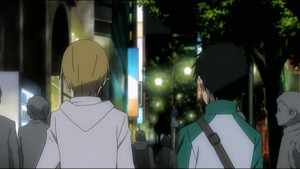
“Additionally from the perspective of the production process by doing this we aimed to save labour,” he says. “However, Durarara!! is by no means the first to use this method of expression, as this visual technique was used in Japanese animation during the late '70s to the early '80s.”
According to Takahiro by episode 11 the animation team had gradually added colour to the extras but it was never a choice they planned to implement from the outset. Instead the decision was arrived at with the knowledge that it would help to amplify the monochrome applications of colour or lack thereof. However, it was not his intention to smuggle in visual critiques of consumer society. But he admits that he would not be surprised if some have eventually found their way into the program.
“I'm naturally cynical,” he says. “Regarding the numerous joke-like bits in the city scenes and street signs these are mainly improvisations by the art director, Akira Itō.”
Tatsuo Yamada, the action director is also chiefly responsible for the fluid and kinetic violent sequences. Takahiro, who is prone to crediting members on his team for bringing together the disparate parts of his unifying vision, prefers to combine suggestion with spectacle.
“Although the whole anime is set in an existing city which is realistic the action or violence depicted by the characters such as Shizuo, Celty, Simon and others is mainly absurd and unrealistic,” he says. “So I did consciously try to make it comical and foremost light-hearted.”
Exteriors appear to take precedence of place in the stylistic design of Durarara!! For Takahiro creating exteriors helps facilitate radical contrast for his animation team.
“Indoors usually contains some light source, so it is quite natural that the lighting is balanced and bright whereas exteriors can be more complex,” he says. “As Celty is a character who manipulates shadows I found designing the blends of actual shadows and the shadows created by Celty – including the suits – quite interesting.”
“Hence the horror film effect,” Takahiro adds, “[you will notice] in some areas.”
Unlike other animation backgrounds Takahiro and his crew, following a suggestion made by Akira Itō, created the shadows of buildings on a different layer and gradually adjusted the darkness accordingly which provided flexibility to choose appropriate levels of shadow for each scene. Formal choices are also predicated on the limits of the creative team assigned to make them work effectively. Selecting directors for each episode is not unlike what a coach might do with his players on a sports team by matching their talents for the required role at hand. Animation producer Yumi Satō helped during this process so that they could balance the visual requirements of each episode with the demands of the narrative.
“We were in production every week so sometimes we were not able to have an ideal match,” Takahiro recalls, “and some of the staff were just placed in their roles through rotation.”
The neo-classic post-war imagery seems borrowed from American cities. You could be mistaken for thinking Edward Hopper hovers over the urban alienation of the environment given the dissonant atmosphere and disconnect that occurs between the estranged characters of the city. Takahiro claims, however, he is not familiar with the American painter's work. Mapping out the visuals for the landscape took time.
“Before we settled with the current art direction Akiro Ito put forward a few illustrations by some artists but none of them clicked,” he says. “We settled on what we have now after some trial and error. I suppose if I had to mention something we used, for reference, some American comics, especially Mike Mignola's work such as Hellboy and Batman: The Animated Series.”
Cultures like colours clash in Durarara!! Despite the overt Irish heritage of Celty Sturlinson, Takahiro says there was no intention to suggest that the character represented Japan's gaijin who are looking for an element of themselves they cannot nominally locate within their native land. It was the creator Ryohgo Narita who first conceived of the headless main character before making the connection between Dullahan and Ireland – a connection which occasions an original interpretation of ancient mythology.
“What we did try to convey here more than anything was that the character in this situation, a foreigner who is not human and doesn't even have a head, is actually the most human-like character that cares about others and tries to love people,” Takahiro says.
But is the search for the missing head another metaphor for Celty's search for an identity?
“This indeed was what we aimed for.”
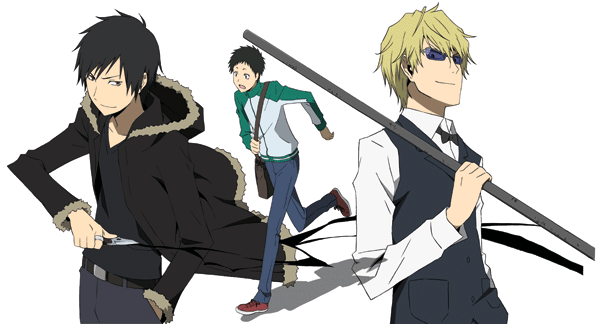
“This is a difficult question. To be honest I think it was only Mr. Narita, the author, who had clearly envisioned the original novel as an animation before production. Maybe even he had no idea what it would be like on film. The images really only started to develop colour once production started and in discussion with the staff and through trial and error and so on. At the beginning we were all in the dark.”
“If I were to give any examples in relation to the question regarding the monochrome depiction of extras (referred to as ‘grey-mobs’ by the production staff), but the scene in episode 11 where the secret of the dollars is revealed and how that spreads like a ripple and the series of cuts and catharsis straight after that where Celty runs down from the roof of Tokyo Hands (although the actual building in Ikebukuro is not that tall). Another episode I would mention is quite different but episodes 16 and 17 the scene illustrating the children under the control of Saika (the Slasher) and who have lost their free will.
Q2. Action sequences are used sparingly in Durarara!! But the violence, when it happens, is both balletic and fluid. How would you describe your approach to conveying violence? Are you more interested in suggestion or spectacle?
“This is another tough question. Although this whole anime is set in an existing city which is realistic the action or the violence depicted by the characters such as Shizuo, Celty, Simon and others are mainly absurd and unrealistic. So I did consciously try to make it comical and lighthearted. Also regarding the animation, there was a lot of input by the action director, Tatsuo Yamada.”
Q3. The look of Durarara!! seems to favour a lot of exteriors. Do you find that drawing exteriors offers greater contrast between the character/environment, colour/lack of light and movement/stillness?
“I guess so. Indoors usually contains some light source, so it is quite natural that the lighting is balanced and bright, whereas exteriors are a little bit more complex, which I believe allows us to create more contrast. As Celty is a character who manipulates ‘shadows’, I found designing the blends of actual shadows and the shadows created by Celty (including the suits) quite interesting, and we also tried to give it a ‘horror film’ effect in some areas. Unlike other animation backgrounds, we created the building shadows on a different layer and adjusted the darkness of it, which gave us the flexibility to choose the appropriate level of darkness of the shadows according to the scene. This was a suggestion by Akira Itō.”
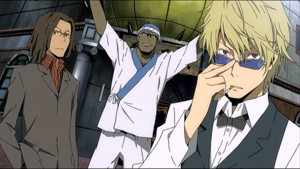

Q4. How do you select the directors for the episodes? Is it a case of matching their talents with the right material like a coach might do with his players and different roles in a sports team? Or are these creative decisions more scientific?
“It is a lot like deciding on players in a sports team. This was done in conjunction with the animation producer, Yumi Satō. However, we were in production every week, so sometimes we were not able to have an ideal match and some of the staff were just placed in their roles through rotation.”
Q5. What is the significance of Celty Sturlinson's Irish heritage? Is this a ‘red herring’ designed to add further mystery to the character or does she represent the gaijin in Japan who are looking for an element of themselves they cannot find in their native land?
“The fairy Dullahan originates in Irish folklore (Celtic Mythology), however it is very well known as a game character in Japan. I think Ryogo Narita first came up with a headless main character, and then made the connection between Dullahan and Ireland. I don't think there's any more depth to that. You have “add further mystery to the character” here, but I guess that isn't too far off. The second half of the question is very intriguing and interesting, but we didn't picture it in that much depth when we started production. What we did try to convey here more than anything was that the character in this situation, a foreigner, not human and doesn't even have a head, is actually the most human-like character that cares about others and tries to love people.”
Q6. Is the search for the missing head another metaphor for the Celty's search for an identity?
“This indeed was what we aimed for.”
Q7. What modern painters do you like? It would appear that Edward Hopper is an influence on your work.
“I am not very familiar with Edward Hopper. Maybe Akira Itō may know, but I don't think that we got our inspiration from there. Before we settled with the current art direction, Akira Itō put forward a few illustrations by some artists, but none of them clicked. We settled on what we have now after some trial and error. I suppose if I had to mention something we used some American comics, especially Mike Mignola's work such as Hellboy and Batman: The Animated Series, for reference.”
Q8. How many people have input into the way music is applied to the scenes?
“For music I basically chose the direction myself then through DB (MA) work I discuss with other stuff such as sound mixers and sound effect staff to decide on the details.”
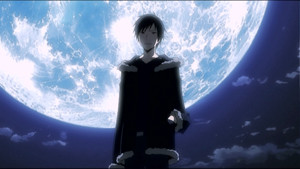

Q9. Are you a fan of jazz? Bursts of brass and double bass are used to emphasise mood which recalls '60s French New Wave cinema. What are some of your own touchstones for combining music and image? Do you have an opinion as to how music should not be used in anime?
“I am a big fan of jazz but the main reason there is so much jazz in this anime is Makoto Yoshimori, the lead of music. We often talk about how the BGM should be freer and so we thought that we would add some sounds that we don't usually hear on TV. He improvises a lot by using instruments which aren't used that often or objects which aren't even instruments. Sometimes the balance is difficult as the sounds (he produces) clash with the sound effects, but we put a lot of weight on unpredictability and uniqueness.”
Q10. What stylistic trends are you expecting to see more of in anime over the next 10 years?
“I don't know. If I talk about the trends in the past 10 years I must say that fantasy and sci-fi which was mainstream during the '80s and '90s are all gone. So from that perspective I feel that they will come back.”
Q11. What is the origin of Durarara!!?
“It's a coined term derived from Dullahan. There is no meaning to it.
Q12. Durarara!! touches on adolescent gang culture in Japan with most of the characters represented as bumbling and used for comedic effect. Is this an attempt to lighten the otherwise dark subject matter? Are you fascinated by the criminal underbelly in Japan?
“I am interested but never have looked deeply into it. I do have acquaintances whom previously belonged to the underbelly society. The colored gangs in this story originate from America but it is outdated over there already and is a culture pretty much forgotten in Japan too. However, it is very easy to differentiate and illustrate on screen just by changing the colour so I thought it would be a shame to reject this concept just because it's out of date. The reason why it has such a comical touch to it is because the other characters are absurdly strong but maybe it's partly there to hide the embarrassment of using such an out of dated culture.”
Q13. Can you describe what it was that inspired you to get involved in animation?
“I always loved the Finnish author Tove Jannson who is well known for her Moomin series of books. So I wanted to write children's books when I was in junior high school. I was pretty much an anime manga otaku in senior high school and produced fan magazines. I would choose a manga which hadn't been turned into an anime yet, imagine how it would be produced and what it would be like as an anime and imagining that it was an actual anime on air, I would write featured reviews of it in that fanzine. Through this, I met some people in the animation industry. As I was about to graduate from high school my father passed away and my school grades weren't that great anyway. So I gave up on going to university and started working as an animator at Studio DEEN which I had some connections with.”
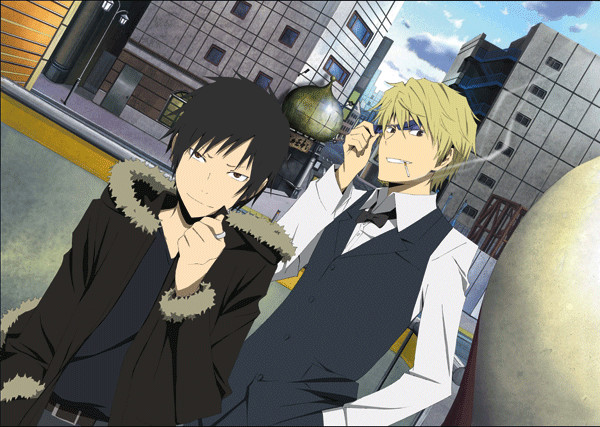

Anime News Network Australia would like to thank Siren Visual and Bill Craske for allowing us to publish this interview.
If you wish to take a closer look at Durarara!! you can check out the listing here in our anime encyclopedia, take a look at Durarara!! on the Siren Visual website Part 1 (out now!) & Part 2 (out this week!) or even check out our review of Durarara!! Part 1.
this article has been modified since it was originally posted; see change history